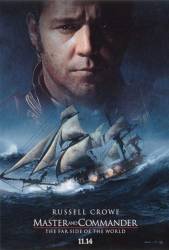Factual error: In the brief shot of the Surprise underway after entering the Pacific, seen from dead astern and from above, the ship is leaving a respectable wake but is not heeling with the wind at all and the sails are hanging slack as though completely becalmed.
Continuity mistake: There are two tight close-ups of the words "hold fast," which are tattooed on Joe Plaice's fingers; When "Engaged enemy frigate at six bells," is said as Joe speaks, and as Stephen performs the brain surgery on Joe. The letters noticeably differ in the two shots, particularly the l, d, f, and t.
Audio problem: The last scene, when the captain and the doctor are playing music, the captain starts out with playing the violin with his fingers. Then the doctor is playing light tones with the bow on his cello. Suddenly, they switch, and the doctor is using his fingers, playing deep tones on the cello, and the captain is now playing with a bow. Finally, the first part of the music piece come back, and you hear both a violin (or some other small string instrument) played with fingers, and another violin played with a bow.
Factual error: In the dinner scene, the captain points and asks the doctor which "weevil". Those are actually mealworm larvae (sold as reptile food in most pet stores in the US) and would never have been in a ship's food. Also, they show the doctor catching common green iguanas, which are not native to the Galapagos Islands. Neither is the species of tortoise pictured in the movie.
Factual error: The (authentic) book on Lord Nelson, that Captain Aubrey gives to Midshipman Lord Blakeney, wasn't published until 1806. The film is set in 1805.
Continuity mistake: The blood on Jack's shirt constantly changes during the final battle with the Acheron.
Factual error: As the Surprise attempts to weather Cape Horn, the wind backs westerly, so Aubrey gives the order to steer South. As the command is passed to the helmsman, he spins the wheel to the left - which would point the vessel Northerly, since the wheel would be turned in the opposite direction.
Other mistake: If the scene in which Jack Aubrey gives the order "hard a larboard" [meaning the opposite of starboard] was indeed a rudder order (ie. turn the rudder in the direction commanded, which turns the ship the other way, in this case to starboard) the face of the compass wouldn't have rotated clockwise. The compass shows a southerly course, rotates clockwise, and eases to show an easterly course, which is a 90 degree turn to port.
Continuity mistake: The order is given to closereef the topsail. But moments earlier, you see seaman doing just that, working on the last reef.
Revealing mistake: After the Captain cuts loose the man who fell overboard in the storm, there is a scene where the men sit around the big table and sing a song. During the song, the camera pans in a sweeping shot around the table. Watch closely as it comes around to the near side of the table, and you'll see the camera's view quickly jolt, as if it lightly smacked against something by accident during the filming.
Factual error: When performing the burials at sea after the final fight with the Acheron, the body on the plank is covered with the wrong ensign. The one shown is not the Union Jack created after the 1800 Act of Union. The correct ensign would be the flag of Great Britain, which does not have the saltire of St. Patrick (the diagonal red "X").






Chosen answer: The flag is a signal flag, and is probably meant to signal that the ship is a whaler or engaged in fishing operations. Such flags were part of an international code, which, with some modification, is still in use today. (The flag is similar to the modern-day "Foxtrot".)